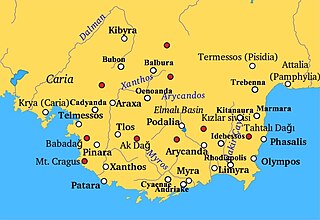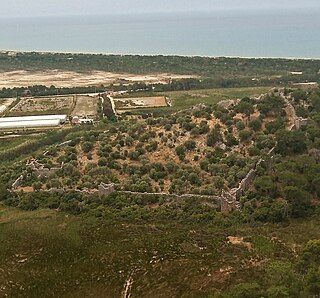Related Research Articles

Lycia was a historical region in Anatolia from 15–14th centuries BC to 546 BC. It bordered the Mediterranean Sea in what is today the provinces of Antalya and Muğla in Turkey as well some inland parts of Burdur Province. The region was known to history from the Late Bronze Age records of ancient Egypt and the Hittite Empire.

Xanthos or Xanthus, also referred to by scholars as Arna, its Lycian name, was an ancient city near the present-day village of Kınık, in Antalya Province, Turkey. The ruins are located on a hill on the left bank of the River Xanthos. The number and quality of the surviving tombs at Xanthos are a notable feature of the site, which, together with nearby Letoon, was declared to be a UNESCO World Heritage Site in 1988.

Olympus or Olympos was a city in ancient Lycia. It was situated in a river valley near the coast. Its ruins are located south of the modern town Çıralı in the Kumluca district of Antalya Province, southwestern Turkey. Together with the sites of the ancient cities Phaselis and Idyros it is part of the Olympos Beydaglari National Park. The perpetual gas fires at Yanartaş are found a few kilometers to the northwest of the site.

Letoon or Letoum in the Fethiye district of Muğla Province, Turkey, was a sanctuary of Leto located 4 kilometres (2.5 mi) south of the ancient city of Xanthos, to which it was closely associated, and along the Xanthos River. It was one of the most important religious centres in the region though never a fully-occupied settlement.
Calynda was a city in ancient Caria.
Sidyma, was a town of ancient Lycia, at what is now the small village of Dudurga Asari in Muğla Province, Turkey. It lies on the southern slope of Mount Cragus, to the north-west of the mouth of the Xanthus.

Cadyanda or Kadyanda was a town of ancient Lycia. The site was discovered by Charles Fellows. The decree of Pixodarus now in the British Museum shows that the Lycian name of the town was Xadawãti.
Daedala or Daidala was a city of the Rhodian Peraea in ancient Caria, or a small place, as Stephanus of Byzantium says, on the authority of Strabo.

Bubon or Boubon was a city of ancient Lycia noted by Stephanus of Byzantium; the ethnic name, he adds, ought to be Βουβώνιος, but it is Βουβωνεύς, for the Lycians rejoice in this form. The truth of this observation of Stephanus is proved by the inscription found on the spot: Βουβωνέων ἡ Βουλὴ καὶ ὁ Δῆμος.

Podalia, also spelled Podalaea or Podalaia (Ποδαλαία), Podallia (Ποδαλλία), and Podaleia (Ποδάλεια), was a town of ancient Lycia, mentioned by several ancient authors.

Nisa, also Nyssa (Νύσσα) or Nysa (Νύσα) or Neisa (Νείσα), was a town in ancient Lycia near the source of the River Xanthus.
Arsada or Arsadus was a city of ancient Lycia, located over the valley of the Xanthus between the ancient cities of Tlos and Xanthus.

Isinda was a town of ancient Lycia. Isinda was part of a sympoliteia with Aperlae, Apollonia and Simena.
Lydae or Lydai was a town of ancient Caria or Lycia in the Rhodian Peraea. Ptolemy notes the city in Lycia under the name Chydae. The Stadiasmus Maris Magni calls the city Clydae or Klydai (Κλυδαί) and places it in Caria.

Pydnae is the site of an abandoned Hellenistic fort on the coast of ancient Lycia in Asiatic Turkey between the River Xanthus and Cape Hieron. It was built to defend the road from the coast to Xanthos, then the most important city in Lycia, and was well placed, being near to fresh water supplies and a safe landing area for shipping. During the period when the fort was controlled by the Romans, it was mentioned in the 3rd century Stadiasmus Maris Magni, and listed by Ptolemy in his Geography. During the Byzantine period, the defensive walls were used to protect the local Christian population from raiders.
Tyberissus or Tyberissos, also Tyberisus or Tyberisos, was an inland town of ancient Lycia, near the ancient settlement of Teimiussa that functioned as its port. The name is not attested in history, but is derived from epigraphic and other evidence. This combination of harbor and inland location is the focus of archaeological exploration. Among the finds are tombs with Lycian inscriptions. Coins inscribed "ΤΥ" of typical Lycian type were probably minted here.
Trysa or Tryssa was a town of ancient Lycia, located between Cyaneae and Myra. It has been archaeologically examined, and among the finds are Lycian tombs, most notably the Heroon of Trysa. Greek inscriptions which were found there show that there was a cult of Zeus Eleutherios and of Helios at Trysa. The town was also inhabited during the Byzantine period and there was a church on the acropolis.
Olbia was the westernmost town on the coast of ancient Pamphylia, which some ancient writers place in Lycia. Ptolemy places it between Phaselis and Attaleia. Stephanus of Byzantium blames Philo for ascribing this town to Pamphylia, since, as he asserts, it was situated in the territory of the Solymi, and its real name was Olba; but the critic is here himself at fault, confounding Olbia with the Pisidian Olbasa. Strabo describes Olbia as a strong fortress, and its inhabitants colonised the Lycian town of Cadrema.
Elbessos was a town of ancient Lycia, which was mentioned in a treaty between Caesar and the Lycian League.
References
- ↑ Stillwell, Richard; MacDonald, William L.; McAllister, Marian Holland, eds. (1976). "Istlada". The Princeton Encyclopedia of Classical Sites. Princeton University Press.
- ↑ Richard Talbert, ed. (2000). Barrington Atlas of the Greek and Roman World . Princeton University Press. p. 65, and directory notes accompanying. ISBN 978-0-691-03169-9.
- ↑ Lund University. Digital Atlas of the Roman Empire.
- ↑ "Lycia :: Istlada". Archived from the original on 2020-08-01. Retrieved 2019-04-09.
- ↑ "Ancient Cities of Lycian Civilization". UNESCO World Heritage Centre. Archived from the original on 2020-05-04. Retrieved 2020-05-03.
36°13′06″N29°53′16″E / 36.218342°N 29.887844°E